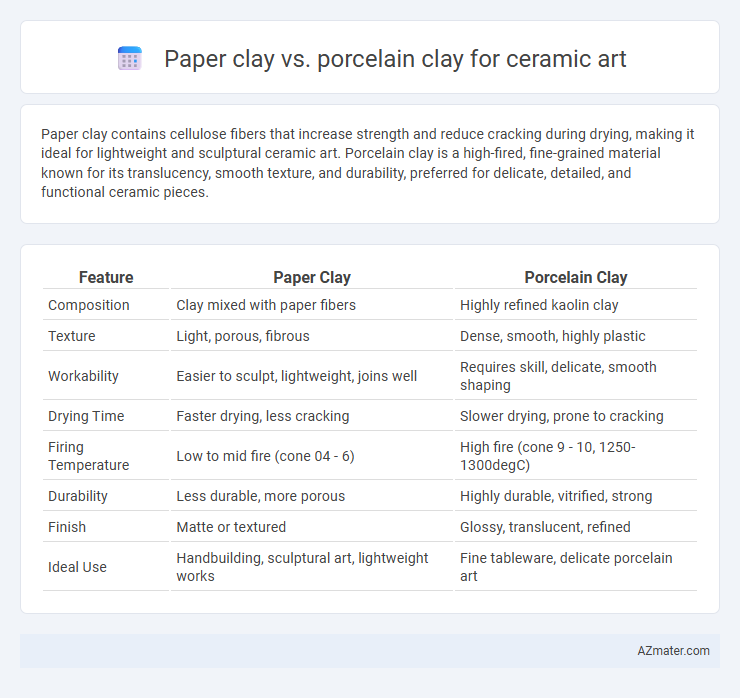Paper clay contains cellulose fibers that increase strength and reduce cracking during drying, making it ideal for lightweight and sculptural ceramic art. Porcelain clay is a high-fired, fine-grained material known for its translucency, smooth texture, and durability, preferred for delicate, detailed, and functional ceramic pieces.
Table of Comparison
| Feature | Paper Clay | Porcelain Clay |
|---|---|---|
| Composition | Clay mixed with paper fibers | Highly refined kaolin clay |
| Texture | Light, porous, fibrous | Dense, smooth, highly plastic |
| Workability | Easier to sculpt, lightweight, joins well | Requires skill, delicate, smooth shaping |
| Drying Time | Faster drying, less cracking | Slower drying, prone to cracking |
| Firing Temperature | Low to mid fire (cone 04 - 6) | High fire (cone 9 - 10, 1250-1300degC) |
| Durability | Less durable, more porous | Highly durable, vitrified, strong |
| Finish | Matte or textured | Glossy, translucent, refined |
| Ideal Use | Handbuilding, sculptural art, lightweight works | Fine tableware, delicate porcelain art |
Introduction to Paper Clay and Porcelain Clay
Paper clay is a composite material combining traditional clay with cellulose fibers, enhancing flexibility, strength, and drying speed for ceramic art. Porcelain clay is a refined, high-quality ceramic material known for its white, translucent appearance and smooth, dense texture, requiring precise handling due to its plasticity and shrinkage. Both materials offer distinct advantages: paper clay improves workability and repairability, while porcelain clay delivers elegance and fine detail in finished ceramics.
What is Paper Clay?
Paper clay is a versatile ceramic material made by mixing traditional clay with cellulose fibers, usually sourced from paper pulp, enhancing its strength and workability. It allows artists to sculpt delicate, lightweight forms that can be joined while dry, reducing cracking and warping during firing. Compared to porcelain clay, which is known for its fine, smooth texture and high firing temperature, paper clay offers greater flexibility and durability for intricate ceramic art projects.
What is Porcelain Clay?
Porcelain clay is a refined, high-quality ceramic material composed primarily of kaolin, feldspar, and quartz, known for its white, translucent appearance and exceptional strength after firing. It requires higher firing temperatures, typically between 1,200degC and 1,450degC, to achieve its characteristic vitrification and smooth, glass-like surface. Porcelain clay is favored in ceramic art for its fine texture, durability, and ability to capture intricate details, making it ideal for both functional ware and delicate sculptural pieces.
Key Material Differences
Paper clay contains cellulose fiber, enhancing flexibility and reducing cracking during drying, making it ideal for delicate or intricate ceramic art. Porcelain clay is refined kaolin with minimal impurities, producing a smooth, translucent, and vitrified finish after high-temperature firing, ideal for fine, detailed work. Structural strength is higher in paper clay during the wet stage due to fiber reinforcement, whereas porcelain offers superior hardness and translucency once fully fired.
Workability and Handling
Paper clay offers enhanced workability and superior flexibility due to its added cellulose fibers, making it easier to join and shape compared to traditional porcelain clay. Porcelain clay is known for its fine, smooth texture and high plasticity but requires more skill to handle because of its tendency to collapse or crack during shaping and drying. Artists often prefer paper clay for complex or delicate forms, while porcelain is chosen for its refined finish and high firing strength.
Drying and Shrinkage Comparison
Paper clay contains fibers that improve drying flexibility and reduce cracking, making it ideal for intricate ceramic art with less risk of warping. Porcelain clay, while prized for its smooth texture and translucency, experiences higher shrinkage rates during drying, necessitating careful moisture control to prevent deformation. Artists often choose paper clay for larger or more delicate pieces due to its stable drying properties compared to porcelain.
Strength and Durability After Firing
Paper clay incorporates paper fibers that enhance its tensile strength and reduce cracking during drying, but after firing, it typically remains more porous and less dense than porcelain clay. Porcelain clay, composed primarily of kaolin, vitrifies at high temperatures, creating a highly durable, dense, and non-porous ceramic body known for exceptional strength and chip resistance. While paper clay is ideal for lightweight and complex sculptures, porcelain offers superior durability for functional ceramic art requiring long-term resilience.
Surface Texture and Finish
Paper clay exhibits a textured, matte surface due to the fiber content, providing a rougher, more tactile finish ideal for expressive ceramic art. Porcelain clay, characterized by its fine particle size and high kaolin content, delivers a smooth, glossy surface with a translucent quality after firing, perfect for refined, delicate works. The choice between paper clay and porcelain clay significantly impacts the ceramic piece's aesthetic, with paper clay favoring texture and porcelain highlighting smoothness and sheen.
Glazing and Color Response
Paper clay offers enhanced glaze adhesion and a unique matte finish due to its fibrous texture, promoting vibrant color absorption and reducing glaze defects. Porcelain clay, known for its smooth, dense composition, provides a glossy surface with crisp, clear colors, but it can be prone to glaze crawling if not properly prepared. Both clays respond differently to glaze chemistry and firing temperature, impacting the final color intensity and surface quality in ceramic art.
Choosing the Right Clay for Your Ceramic Art
Paper clay offers enhanced workability and lightweight properties due to its cellulose fiber content, making it ideal for intricate and delicate ceramic art pieces. Porcelain clay, prized for its fine texture, translucency, and high firing temperature, provides a smooth, durable, and refined finish suitable for advanced ceramic techniques. Selecting between paper clay and porcelain clay depends on your artistic goals, firing capabilities, and desired texture, with paper clay being more forgiving during construction and porcelain best for achieving a polished, professional look.

Infographic: Paper clay vs Porcelain clay for Ceramic art
 azmater.com
azmater.com